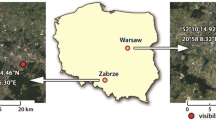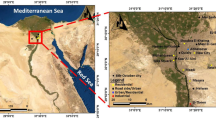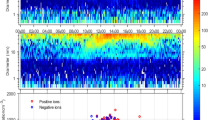Conclusions
There is no doubt that positive and negative ion concentrations are influenced by meteorological conditions. But this dependence on weather is due to the given atmospheric content and size of aerosol particles which the small ions attach to (Lassen and Rau, 1960). Consequently, minimum values are found in fog and low visibility, respectively, high values at high visibility, fair weather without precipitation, but also during foehn conditions. However, the latter are in no way distinguished by special features compared to other weather conditions that favor the increase of ion concentrations. This relates to ion concentrations of both signs as well as the ratio from positive to negative concentrations.
On the basis of an extensive data material it was possible to confirm again what has been observed long time ago (Reiter, 1960). Weather-dependent effects of foehn ⦓ften claimed but never convincingly proved —can no longer be explained by abnormal ion conditions. This conception should once and for all be put to the realm of stories. Advertisements from the commercial side according to which strong excess and high concentrations of negative ions will generate a “well-being” like that in high mountains or other open countrysides are completely unfounded. It even needs to be pointed out that in a mountainous region during fair weather the ratio of the small ion concentration is shifted more towards positive ions. Similarly, this is true of conditions in roof-gardens and even balconies of multi-storey buildings.
Similar content being viewed by others
References
LASSEN, L. and RAU, G. (1960): Die Anlagerung radioaktiver Atome und Aerosole (Schwebstoffe). Z.f. Physik 160: 504–519.
REITER, R. (1960): Das luftelektrische Erscheinungsbild des Süd-Föhns nach synoptisch-klimatologischen Untersuchungen im Wettersteingebirge 1955–1959. Arch. Met. Geophys. Biokl. 12: 68–124.
Author information
Authors and Affiliations
Rights and permissions
About this article
Cite this article
Reiter, R. Part B Frequency distribution of positive and negative small ion concentrations, based on many years' recordings at two mountain stations located at 740 and 1780 m ASL. Int J Biometeorol 29, 223–231 (1985). https://doi.org/10.1007/BF02189654
Issue Date:
DOI: https://doi.org/10.1007/BF02189654




